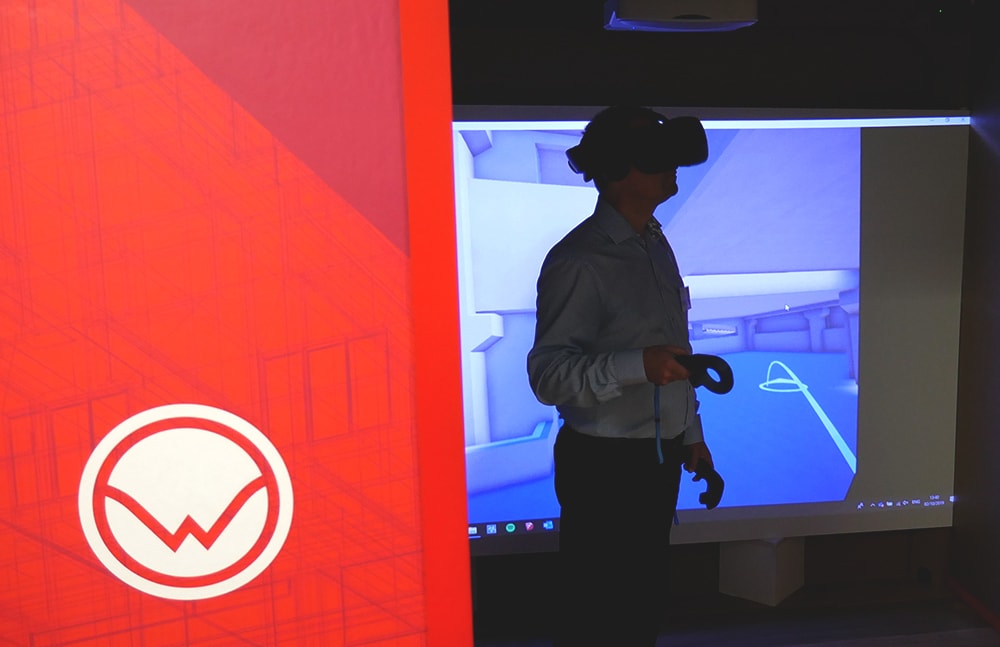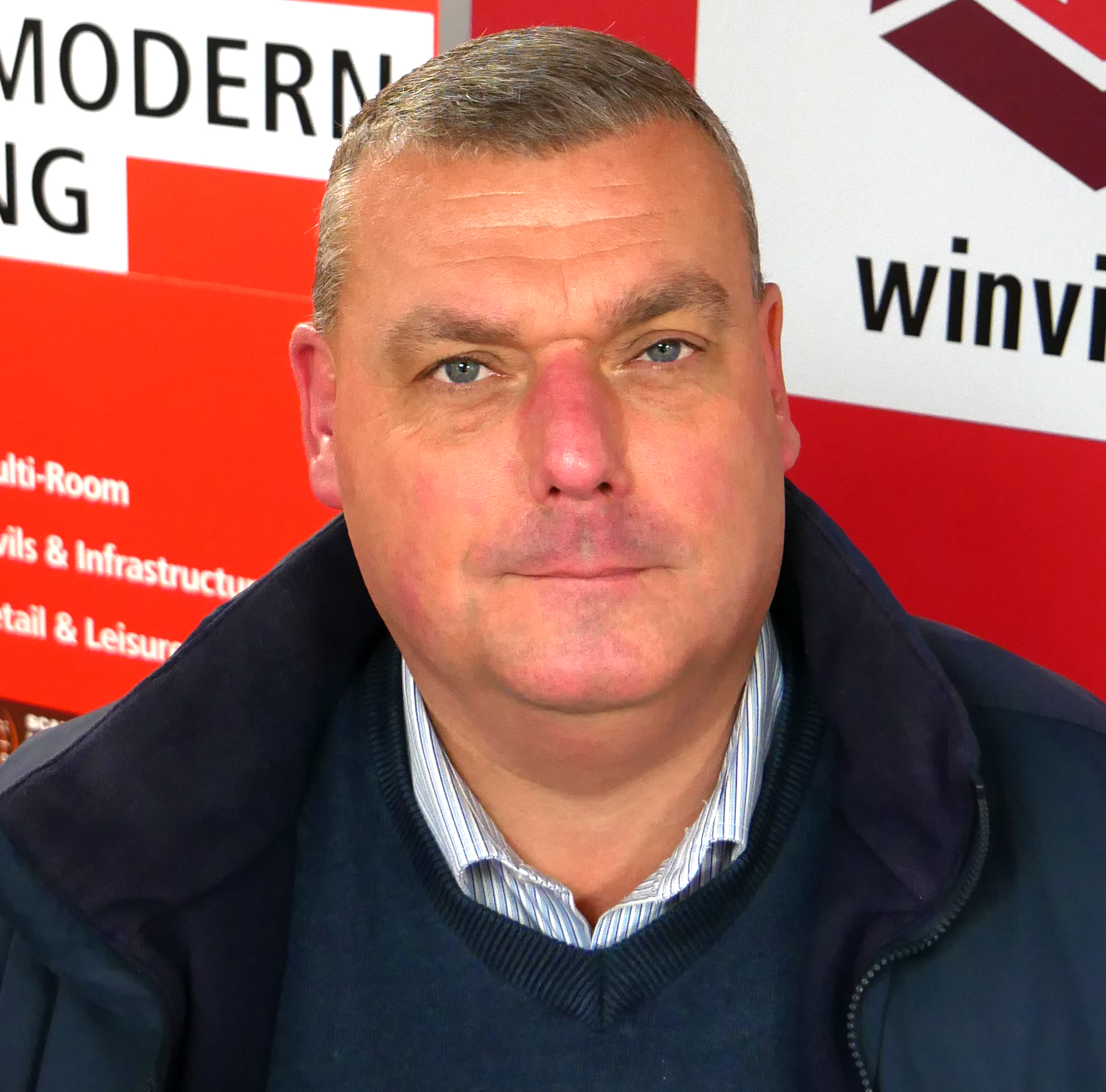Winvic is punching well above its weight in terms of its commitment to digital technologies. Andrew Pring finds talks to Tim Reeve, technical director, about its strategy.
While some medium sized contractors may be happy to sit on the sidelines and bemoan the fact their clients aren’t interested in BIM Winvic Construction is doing is going all out to demonstrate the benefits. The £600m turnover main contractor specialising in turnkey solutions for industrial, build-to-rent, student accommodation and commercial projects has launched a Centre for Innovative Construction (CIC) with a virtual reality BIM cave and voice-activated BIM trialling programmes.
The 2,000 sq ft CIC is sited at Winvic’s Northampton head office, and is designed to facilitate interactive experiences within design models. This ranges from clash detection and dimensional design checks to spatial awareness assessment and data asset information retrieval, allowing Winvic staff, consultants and suppliers to interact and make live design changes.
The BIM cave has a 125-inch screen for 3D model viewing, an interactive meeting room allowing real-time design changes on 86-inch smart screens, and a training space that will enable 360-degree education across the business and the supply chain.
Variations can be effected remotely or via the interactive design meeting room and be instantly viewed in three dimensions, with the 3D headset and controller allowing the BIM cave user to travel around a site or building.
Tim Reeve, technical director at Winvic, says: “We have offered industry standard BIM Level 2 to clients for many years, but in the last two to three we have experienced a significant uptake in the request for BIM on the projects we are involved in and they now represent nearly one third of our turnover. However, to meet clients’ future needs, we wanted to become an early adopter of the technology found in our new facility.
“Clients often can’t visualise what you’re trying to achieve but when we bring them here, they are very enthused by what they see.”

The BIM cave is part of Winvic’s new Centre for Innovative Construction
Reeve says that client demand for a more sophisticated offer has been particularly strong among property developers. “Some key developers see a real benefit in the BIM model, particularly at the end of the construction process as a benefit for incoming tenants who can use it as an FM work manual.”
End-users can retrieve sections of their scheme’s design manual, maintenance guidance or 360-degree photos with a simple click or via a QR code, and QR codes within finished buildings can link to pertinent manual information or other online content.
Reeve believes that by being able to strategise with clients, end-users, consultants and suppliers through a digital approach – from as early as the PQQ and tender stages – will be “transformational” for its business and also the companies it works with.
Shaping accurate budget and planning complex programmes using 4D modelling provides Winvic with the means to manage schemes at very detailed levels, as well as model construction challenges into solved problems and execute construction phases faster. Project developers and building occupiers profit from shortened timescales and reduced costs end-to-end.

We see a clear opportunity to use the centre to augment our staff and supply chain training, from general health and safety to specifics on projects. Getting BIM buy in from our supply chain is crucial for us, and we’re keen to help them gear up to what we’re doing.– Tim Reeve, Winvic
The new CIC is also helping Winvic in its partnership with the University of West England, Bristol (UWE), which is exploring voice-activated BIM, with Costain as the third partner.
Through the Research Leaders programme, Winvic is providing UWE with BIM data – or “construction access” – which will be instrumental in the creation of an intelligent voice search headset. Running the Conversational BIM project is UWE Professor Lukumon Oyedele who is developing technology to allow people to make voice requests to a BIM model – from an office or on site.
Over time, the software will recognise individual users’ voices and be able to anticipate requests. When available shortly, Winvic will be one of the first to trial this ground-breaking technology on one of its projects.
Commenting on the project, Professor Lukumon Oyedele, assistant vice-chancellor for digital innovation and enterprise at UWE Bristol, says: “Until now, conversational AI has mostly been used in labs and controlled settings. Here, we are bringing it into a construction environment, where workers are using their hands and need a quick and effective way to gather information.
“We hope that this technology will augment workers’ capabilities, to make construction more efficient. It is about improving worker’s productivity, ensuring a faster delivery process and getting it right the first time by avoiding defects.”
Reeve adds: “It’s a real honour to be working with Lukumon on his research project and because we share a vision of doing things right and a passion for technology it is also a pleasure. AI can have relevant applications in unexpected places, and we’re eager to test the voice activated headset that our data is helping to create.”
CIC will also help Winvic get its supply chain up to speed with the latest developments, as well as providing other training and health and safety benefits. Reeve says: “We see a clear opportunity to use the centre to augment our staff and supply chain training, from general health and safety to specifics on projects. Getting BIM buy in from our supply chain is crucial for us, and we’re keen to help them gear up to what we’re doing.”















